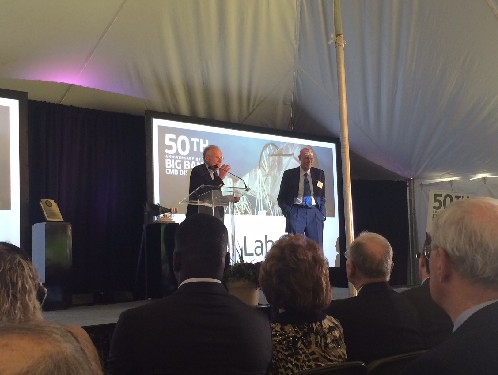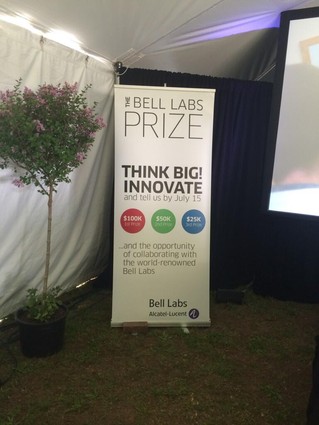Alcatel-Lucent’s Bell Labs Hiring 20 Postdocs in NJ as it Beefs Up Brand, Celebrates Past and Future

New Jersey’s Bell Labs (Murray Hill), the research arm of Alcatel-Lucent (Paris), has hired one or two postdoctoral fellows (postdocs) per year for the past few years. Now Bell Labs has decided to ramp up its hiring.
The New Jersey lab will add 20 postdocs this year, in line with a rebranding, refocusing effort aimed at renewing an emphasis on research.
There are now some 150 postdocs at Bell Labs in New Jersey, so this hiring spurt represents an approximate 15 percent to 20 percent increase in basic researchers. In total, the company plans to hire some 100 additional researchers.
This represents significant regrowth,” Marcus Weldon, Bell Labs president and Alcatel-Lucent CTO, told NJTechWeekly.com in an interview May 20, 2014. We spoke with him at the Holmdel site of the Horn Antenna, where the company was celebrating both the discovery of Big Bang cosmic radiation and the future of Bell Labs.

It was a day that anyone involved with technology would have reveled in. For one thing, Robert Wilson and Arno Penzias discussed their Nobel Prize-winning discoveries in human terms.
Additionally, Bell Labs researchers presented some of the big problems they are working on in future optics, future wireless, future objects and the Cube — a responsive individualized network solution. Weldon called this a “digital sixth sense.”
“When you think of this idea, there is a massive challenge ahead of us that in my opinion outstrips anything we’ve had to do so far in communications,” Weldon told the audience. The industry has been making one-dimensional improvements, he said. To make this idea happen, “we have to change everything at once,” he noted.
Weldon said Bell Labs is invigorating its basic research, going back to those productive days during which researchers were instructed to pursue any line as long as it was related to the business of communications and when they looked for big problems to solve.
“We are returning Bell Labs to the days of Penzias and Wilson, when we researched big ideas,” he said, and “you have the knowledge base to see the things off to the side that give rise to the great discoveries.”
In this day and age, however, researchers study problems related to both information and communications. Bell Labs calls these kinds of endeavors “10x game-changing research and cross-discipline FutureX projects.”

Weldon stated that the Bell Labs Prize, announced May 20, 2014, will attract startups and independent researchers to the famous New Jersey site. “We are launching it globally — officially in 43 countries. The idea is to find those 10x game-changing ideas,” he said.
Bell Labs expects to take someone’s external idea, combine it with the lab’s internal capabilities and, said Weldon, “We will imagine a new reality.”
As many as 50 researchers with game-changing ideas will be paired with Bell Labs researchers for a two-month period in phase two of the contest. They will innovate together at Bell Labs in whatever way they can: remotely, in person, as theorists working with experimentalists, simulations and prototypes being built, Weldon said.
“A panel of industry experts and luminaries will judge which of these ideas have the ability to transform how we connect, collaborate and communicate” at the end of the two months, Weldon said.
A $100,000 first-place prize is at stake as well as a chance to further develop the idea, where possible, at Bell Labs. The company says it will hold this contest annually. The first applications are due July 15, 2014, and can be found on the Bell Labs Prize website.
Fundamentally, the Bell LabsPrize is designed to get people to connect with the company, Weldon told us. “It’s a funnel into the Bell Labs sites, of which New Jersey is probably the most famous,” he added. “The global pool of innovators, rather than being distracted by Silicon Valley, … will be focused on Bell Labs sites,” he said.
The lab is a “unique environment for them — different intellectual perspectives, longtime scale of innovation, which allows you to innovate in different ways with industrial lab support,” Weldon added.
Industrial labs — as opposed to a “venture capital company, where the return on investment has to be within a few years” — should be viewed as strong entities that provide a framework of security, allowing researchers to go off and solve problems, he said.
“An industrial lab setting lets you take risks that are greater in some ways, because your horizons are much longer. We can take risks that are 10- to 20-year risks,” stated Weldon.
Weldon said he encourages his researchers to take on big ideas that have to do with information and communications technology. “We want to look at what the world we want to live in looks like, what we need to do to create the world, what … problems are involved in creating that world. Then let’s solve those problems,” he added. He said he wants to set up Bell Labs and Alcatel-Lucent to thrive in the future.
Weldon acknowledges that today’s Bell Labs differs markedly from the entity it was in the past. Among the reasons for this: a decline in manpower and the fact that under Alcatel-Lucent, Bell Labs is dispersed globally. It comprises several industrial labs throughout the world, including a new one in Israel, dedicated May 20, 2014.
With multiple global labs, there is less of that serendipitous rubbing of elbows with people from other disciplines, of getting their perspectives and hearing their ideas over lunch.
To help encourage spontaneous collaboration, the company has taken special measures. “We do have a rotation program. Researchers move between sites, staying in each site for 80 days, forming deeper relationships and [then going] back to their home lab,” Weldon said.
The company is also working on a FutureX project that involves helping people to get to know their peers, even when they know very little about them. Difficult to describe, the project will use computing and communications technology to present information and context to researchers as they meet others. Also, when researchers enter a new Bell Labs site, they’ll be informed if others whom they know are also visiting or are located at that site, and they’ll be provided information about them.
“We are testing this between our locations,” Weldon said, “so that people feel more connected with each other even though they are at remote sites. Obviously there is videoconferencing, but it doesn’t really work to establish strong connections.”
NJTechWeekly.com will have more from our interview with Bell Labs President Marcus Weldon in a future article.

